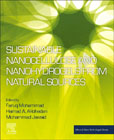
Sustainable Nanocellulose and Nanohydrogels from Natural Sources
Mohammad, Faruq
Al-lohedan, Hamad A.
Jawaid, Mohammad
Sustainable Nanocellulose and Nanohydrogels from Natural Sources explores the use of biopolymers in specific application areas such as electronics, energy, consumer goods, packaging materials, therapeutics, water treatment and engineering, and what makes the particular polymer to engage it in these applications. This is an important reference source for those who would like to learn more about how biopolymeric nanocomposites are used in sustainability and environmental protection. Biopolymers, including plant and sea-based polymers, play an important role in the formation and maintaining the stability of industrial nanocomposites; their common functions being the surface modification and protection for the highly oxidative-unstable cores, as stable base for holding multiple targets, and as a shield for the inorganic and highly toxic metals. These biopolymer-based nanocomposites are being used for applications in the electronics, automobile, construction and biomedical sectors. Explains the major design and development techniques of novel biopolymer-based nanocompositesDemonstrates how Nanocelluloses and Nanohydrogels are being used for environmental health and safetyExplores how biopolymer-infused nanocellulose and nanogels are less toxic than their conventional counterparts INDICE: Section A: General Introduction on Nanocelluloses and Nanohydrogel Matrices 1. Introduction of nanocellulose and nanohydrogel-based composites: Fundamental and general applications 2. Survey of nanocelluloses and nanohydrogels 3. General aspects of nanocellulose and nanohydrogel matrices applicable for sustainability, clean environment and human health 4. Market analysis and commercially applied cellulose and hydrogel-based composites for sustainability, clean environment and human health Section B: Nanocelluloses and Nanohydrogels towards Sustainability 5. Nanocellulose and Nanohydrogels for the development of cleaner energy and future sustainable materials 6. Nanocellulose and nanohydrogel-mediated sustained drug delivery: Smart medical technology 7. Current role and future developments of biopolymers in green and sustainable chemistry and catalysis 8. Review of Nanocellulose and Nanohydrogel matrices for the development of sustainable future materials 9. Nanocellulose and Nanohydrogel matrices as sustainable biomass materials: Structure, properties, present status and future prospects in construction and other engineering 10. Biopolymers-mediated sustainable high performance materials for automobile and aviation engineering applications 11. Nanocellulose-mediated fabrication of sustainable future materials 12. Biopolymers involved sustainable packaging for food, cosmetics and pharmaceuticals Section C: Nanocelluloses and Nanohydrogels for Environmental safety and Health 13. Cellulose and hydrogel matrices for environmental applications 14. Antioxidative response mechanisms of nanocelluloses and nanohydrogel matrices 15. Role of nanocellulose and nanohydrogel matrices for the remediation of persistent environmental pollutants 16. Plant biomass-mediated nanocomposites for the adsorption and removal of radioactive species 17. Recent developments in nanocellulose and nanohydrogel matrices towards stem cell research and development 18. Dynamic electromechanical properties of cellulose and hydrogel matrices for stem cell research 19. Manufacturing technology on nanocellulose and nanohydrogel matrices 20. Pre-industrial and industrial processing and practical applications of nanocelluloses and nanohydrogel matrices
- ISBN: 978-0-12-816789-2
- Editorial: Elsevier
- Encuadernacion: Rústica
- Páginas: 500
- Fecha Publicación: 01/04/2020
- Nº Volúmenes: 1
- Idioma: Inglés
